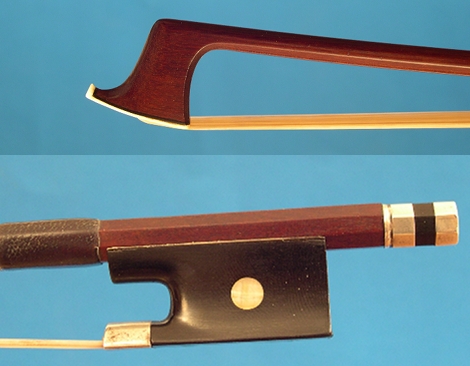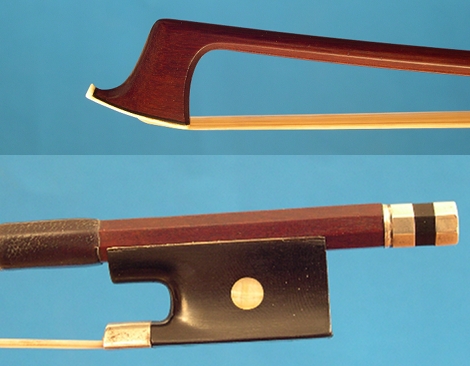PIERRE SIMON, THE NICE PECCATTE
Excellent craftsmanship , even if not like Him. Great sense of proportions and geometry, but less intense. Pierre Simon is undoubtedly the only one, after Peccatte of course, who was closer to the great master, although he never reached his level. We can consider him the other side of Dominique Peccatte: the nice one !

Silver and ebony violin bow by Pierre Simon, 1855 ca.
Like most bowmakers in France Pierre was born in Mirecourt on December 1, 1808, by Charles Simon, a professional mason and Marguerite Caye.
He began his apprenticeship, along with his brother Barthélémy, in the workshops of his home town, and already as a young man, he stands out both for the excellent cratsmanship and for his "rowdy" character, as Raffin describes him . As Grand Adam, he is arrested for being drunk and shouting at night, on February 18, 1834. What can you do, wine is the true inspiration of bowmakers !
After having completed his training, thanks to the friendship born at an early age with Dominique Peccatte in Mirecourt, he moves to Paris in 1838 and begins working for him. As you may remember,it is the same year in which Peccatte leaves J.B.Vuillaume and and takes up Lupot II's workshop.
This is particularly important because in Vuillaume's workshop, Fonclause was the only one left but he went away in 1840, and probably Peccatte was charged with finding a proper replacement . He will stay by him for two years, he fully absorbed the aesthetics that he will never leave for the rest of his career.
In 1840 the place was free, and Simon gets hired by Vuillaume in a permanent way. He will work by him until 1844, when he opens his first workshop at the number 13 in rue Croix des Petits.
In '46 we moved to the number 39, in rue Coquille and after another two years, in '48, he takes by Dominique Peccatte the workshop once owned by Lupot.
On December 11, 1847, he marries Jeanne Génij, Michel's sister, bowmaker as well .
From 1848 until '51 he makes a partnership with Joseph Henry, his former colleague at the time of the Peccatte's workshop , but the cooperation does not work too well, so here after our little Pierre moves once again, to 179 rue Saint Honoré.
In 1852 the name of Simon disappears from the Paris Trade List and for more than twenty years he will not reappear in it. Nobody knows where he was from '52 to '75 although there are traces of a Pierre Simon living in Mirecourt in the same period.
He died in the most classic way, with the plane in his hand, on December 12, 1881, after having worked for Vuillaume and Gand and having built thousands of bows, many of which are still able to rival those of his teacher.
The character
As already mentioned at least for the style of the heads Pierre Simon takes his main, even if not only, inspiration by Dominique Peccatte. The frogs, instead, are the intersection between this one and J.P.M.Persoit's ones.

The general outlines of the head are Peccatte's, but the character is obviously another one and the point where it is most noticeable is around the bevel. While Peccatte's turns high then straighten up on its arrival on the foot, Simon's almost makes a semicircle. This difference, albeit small, helps to completely change the geometry. Entering so much one gets a feeling of lightness of the whole head.
For the frog he moves in two directions. It keeps the overall dimensions by Peccatte, including the length of the plate and the ring, but the throat definitely veers toward the Persoit; square with a more carved cheek especially when it arrives on the the ring.
I consider Pierre Simon as one of the finest of all time, one step, but only one, under the fantastic four, Tourte, Persoit, Peccatte and Pajeot. His bows , as well as being highly appreciated by musicians for their excellent tonal quality and mechanical properties, are also admired by the manufacturers, who recognize in him a uniqueness unknown to most, probably thanks to his nice bevel.
So long
Paolo
|
 
 |